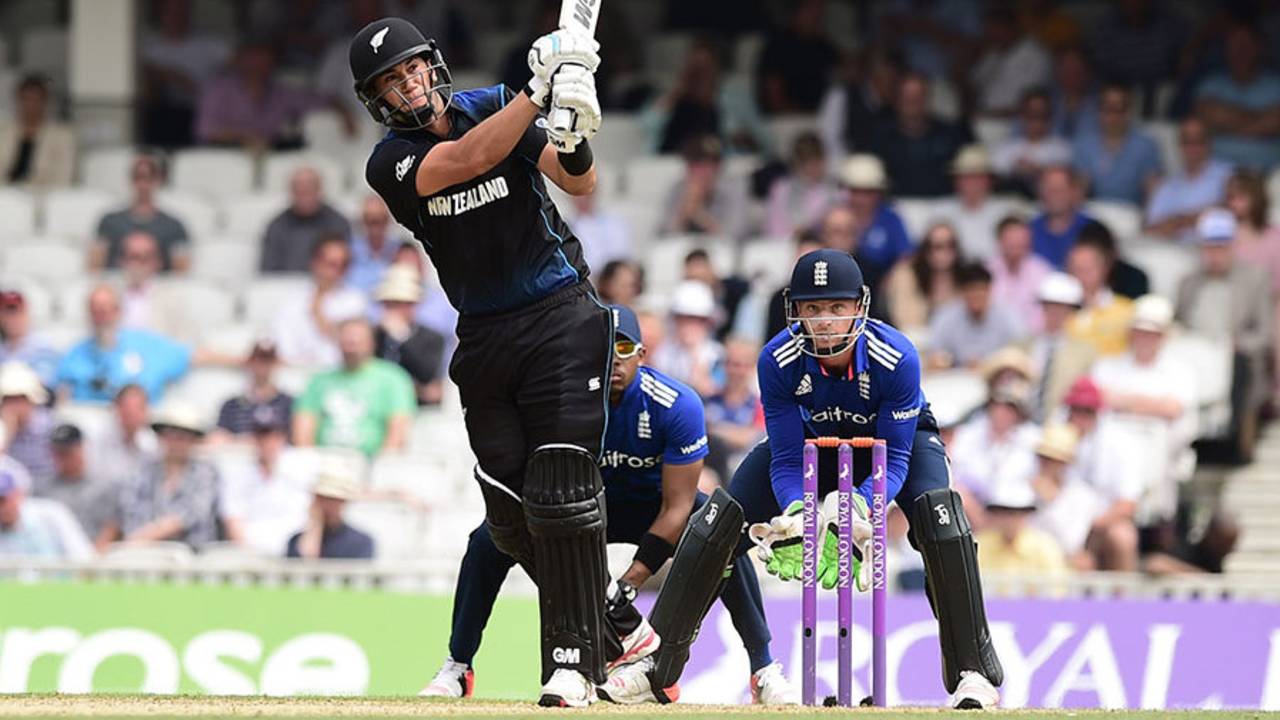At the end of the New Zealand innings, as Mitchell Santner sliced a thick edge down to third man for a single, an ironic cheer went up around the ground. New Zealand had finished on 398 for 5, narrowly failing to emulate England's achievement in the first ODI of passing 400. A small victory but one plenty of Englishman - a few sweat-stained bowlers among them - were willing to take at the time.
England had promised a brave new world of one-day cricket and delivered it in style at Edgbaston. Three days later, the Big Dipper went careening on, to the extent that England were still in contention to pull off the second-biggest run chase in history of ODIs going into the last few rain-affected overs.
In some senses, the result did not matter. New Zealand had promised to roll out the artillery and The Oval responded with generous applause; that they were pushed so close only enhanced the sensations on a night that must rank as one of the giddiest in England's one-day history (and coming so soon after the other one). Even a rain delay as the climax approached could not wash away the good vibes.
New Zealand could already take some of the credit for inspiring their once-staid opponents, though they prefer to accept victories along with the plaudits. This New Zealand team have been surfing the crest of a zeitgeist for some time, endearing themselves wherever they go - on the trains into Vauxhall, people could be heard marvelling at the unfettered, unaffected style of play that
Brendon McCullum's team routinely go in for.
McCullum might have tried to be too clever by inserting England in the first match but he fell back on a trusted tactic after winning the toss here: if in doubt, pile 'em up. The charge from McCullum, with 39 from 22 balls, beat out a tattoo of intent, while Martin Guptill mixed caution with scything strokeplay in reaching a half-century that was sedate - just under a run a ball - in comparison to the rest of the match.
The twin pillars of a victory that England attempted to shake to its very foundations were provided by the next men in, however.
Kane Williamson, with his first 50-plus ODI score since the opening match of the World Cup, and
Ross Taylor, who had led New Zealand's forlorn effort at Edgbaston, gave a display of boiler room efficiency that is a key component for their team's success. Yes, there was even room for efficiency among 763 runs.
"I didn't think anyone went nuts, no one played an amazing innings like Eoin Morgan but it was still good enough to get us to close on 400," Taylor said. "That just shows you what partnerships can do to a team, in building momentum."
The two openers, McCullum and Guptill, were New Zealand's leading run-scorers at the World Cup and such was the destruction they regularly wrought, the relative lack of returns of Nos. 3 and 4 was no impediment to their reaching the final. But the sight of their contrasting styles dovetailing smoothly again would have been another reason for McCullum to crack a flinty grin on the team balcony.
Williamson has already notched a century on tour, in the Lord's Test, and made a significant contribution to New Zealand's World Cup campaign with the nerveless six he crashed off Pat Cummins to see off Australia
in Auckland. This innings, full of deft touches, whipcrack pulls and lofted drives, was a throwback to his ODI form leading into the 50-over tournament, when he recorded three hundreds, and two scores of 97, in eight innings against Pakistan and Sri Lanka.
The 15 runs Williamson took off Adil Rashid's eighth over included a six so precise that it plopped directly on to the boundary rope and consecutive fours straight-driven on a gossamer thread over the head of mid-off.
Williamson almost seems to chuckle to himself when praise comes his way, deflecting such comments in the same manner that he dextrously manipulates the ball. Taylor is perhaps a little more blunt as a speaker but his approach with the bat, when he gets going, is entirely direct. Williamson looks so good it hurts; Taylor hits so hard it hurts.
Three times he dumped the ball over long-on, twice threatening the spectators in the second tier of the OCS stand. There is probably nothing quite so satisfying as a club over cow corner, from village green to international arena.
Taylor actually began a little tentatively, allowing Rashid a brief period of control, and he was dropped on 7, cutting Liam Plunkett hard past point where Jason Roy could not hold on. Roy thumped the ground in frustration and that sense would only grow as Williamson and Taylor added 121 in 17.4 overs, the partnership growing steadily more expansive. Both went on to their most significant scores since hundreds apiece - Taylor's again unbeaten - took New Zealand to 369 for 5 against Pakistan
in Napier in February, amid the stirrings of a World Cup charge.
That score would have been plenty enough to break the mark for the biggest ODI total at The Oval but, having reached 235 for 2, New Zealand pushed further onwards and upwards through rat-a-tat bursts from Grant Elliott and Luke Ronchi. Taylor, like Williamson, had reached his fifty from 52 balls and he measured another 69 from the last 44 of his innings - though he could not quite see his side past 400 for only the second time, it was still the highest mark by a visiting team in England. It turned out to be just enough.
Alan Gardner is an assistant editor at ESPNcricinfo. @alanroderick
